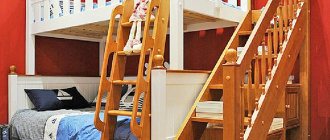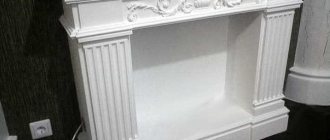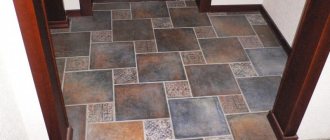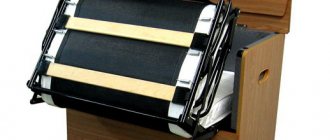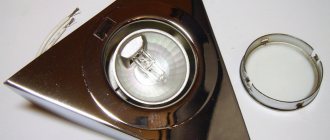Design of a small, bright bathroom with efficient use of space
Nowadays, small-sized studio apartments, or apartments in the so-called “Khrushchev” buildings, are very popular, where every centimeter must be used correctly in order to get the maximum benefit from the space. For a modern interior, beautiful, high-quality and functional furniture is the main rule.
A cabinet for a washing machine in the bathroom allows you to close the machine and use the rest of the space for storing household chemicals, towels, and linen.
One of the important points is the equipment of the place for the washing machine. It doesn’t matter where it will be - in the bathroom, hallway or kitchen. Installation in the bathroom is of course much simpler than, for example, in the kitchen. No additional hosing is required for installation.
Cabinet for washing machine in the bathroom in a built-in niche
To save space in a room or disguise household appliances, it has become popular to build a cabinet above the washing machine.
A built-in cabinet for a washing machine in a small bathroom allows you to properly use the free space
Washer and dryer in a cabinet with convenient and functional shelves and drawers
Let's start with the positives.
The cabinet for the boiler above the washing machine protects it well from prying eyes and serves as additional storage space
A built-in wardrobe can only be installed in large rooms. It requires quite a lot of space, so this option, unfortunately, is not suitable for small apartments.
Rack with open shelves above the washing machine in a small bathroom
The only downside is that you may not notice the leak in time if the washing machine is installed inside. Also, the cabinet may not last long, but this will depend on the material you choose for its manufacture.
White homemade cabinet above the washing machine installed in a niche
Minimalist bathroom with washing machine placed under the cabinet
Selection of building materials
Cabinet above the washing machine made of white semi-gloss laminated chipboard, made independently
Before choosing building materials, you need to carefully and accurately measure the bathroom and washing machine. Different models have different dimensions. Then you need to make a drawing, taking into account the dimensions of the cabinet. It should be 3-4 cm wider than the washing machine.
A small wall cabinet above the washing machine in a niche
In terms of height, choose the option that is most suitable for you, it can vary from 2 to 2.5 meters. The higher the structure, the greater the number of functional shelves. Please note: the tall structure is unstable. The size of the cabinet should correspond to the size of the bathroom; large furniture in small rooms looks awkward and takes up a lot of space.
Moisture-resistant MDF for making a bathroom cabinet
After taking measurements, we go to the store and select moisture-resistant MDF, which is the most suitable and budget option for making furniture. This is a relatively new material, which is obtained by pressing fine dry sawdust. But at the same time, it is very resistant to aggressive environmental influences. When choosing MDF, you should pay attention to the thickness, choose the required color and texture. It must have a PVC coating for additional protection from moisture. The MDF thickness required is at least 19-20 mm; with such parameters, the cabinet will be very reliable and can withstand a washing machine, the weight of which is about 80 kg.
Carefully examine the surface of the product for chips and scratches. Start making.
Equipment and tools for cabinet making
You will need a fairly standard set of tools:
- drill;
- screwdriver;
- jigsaw;
- metal corners;
- screws;
- tape measure, pencil.
Before making the cabinet, we calculate the dimensions of all parts. The intermediate shelves will be 10-15 mm shorter than the bottom and top walls. We make markings and cut out parts to individual sizes. You can order ready-made material, which will be cut on a special machine.
Details of the future shelf made of white MDF
Step-by-step instruction:
A cabinet with a machine inside and shelves, built into a bathroom niche
In some cases, the washing machine is not closed with a door, and it “fits” harmoniously into the new interior. A white washing machine can be placed in a classic snow-white bathroom, and a gray metallic one will suit a bathroom with gray ceramic tiles.
Large cabinet above the washing machine near the shower
If there is no time and opportunity to place a cabinet, a simpler and more affordable option is possible - placing shelves above the washing machine. They can also store various accessories that are necessary for daily care.
Convenient shelves above the washing machine
They can be made from available materials, for example, pieces of MDF that could have been left over after renovating an apartment, or from glass coated with film (for easier maintenance).
Spacious, hand-made closed bathroom cabinet
Bathroom cabinet with space for a washing machine
Should I buy ready-made furniture, or create a budget-friendly and most suitable universal rack or cabinet? In any case, the choice is yours.
Corner cabinet with built-in washing machine
Washing machine in a small bathroom with convenient and functional cabinets and shelves
Photo selection of cabinets for a washing machine in the interior:
Where to install a washing machine in a small apartment is a question that each owner decides in his own way. Such equipment seems to be located in the bathroom. But due to the small area of this room, it is not always possible to find a place for a suitable washing machine here.
Therefore, quite often the washing machine is placed in the kitchen, installing it next to the sink. There is also good access to water supply and drainage pipes. But the presence of a washing machine in the kitchen still, firstly, reduces the useful volume of the kitchen space (a table that is more necessary in the kitchen could be located here), and secondly, and this is perhaps the most important thing, the constant fuss with linen and washing powder is a very unattractive activity that does not go well with cooking. And from a hygiene point of view, this is not advisable.
On the other hand, in most apartments, both one-room and two-room in old houses, you can easily install a washing machine in the hallway. It is quite possible that someone in this place has a built-in wardrobe (I know this from my own experience). So it’s worth getting rid of this closet, and for outerwear a small hanger is enough (that’s exactly what we did). You can, of course, embed a washing machine into this built-in cabinet, but it seemed to me that this option is less aesthetically pleasing.
The decision has been made - we install a washing machine in the hallway. You just need to connect it to the water supply, sewerage and electrical networks. All the elements necessary to connect the washing machine are included in its kit, but they are short in length.
To connect to the electrical network, given the rather large power of the heating elements of the washing machine, you should lay a separate cable from the distribution board and connect it through an RCD (residual current device). In this case, the outlet should be located next to the machine to prevent the use of an extension cord. In addition, it must be the same type as the plug and designed for the maximum power consumption of the machine.
But the main question is how to connect the water supply and drain hoses to the washing machine. Since one of the walls of the hallway where the washing machine will be installed is adjacent to the bathroom, these hoses must be passed through a hole made in this wall. And in the bathroom you can always find a way to install and connect them.
Having chosen the connection points for the drain and water hoses, we determine their required length. It should be taken into account that the hoses must have some reserve, allowing the washing machine to move slightly. In addition, the drain hose of some washing machines requires an additional reserve, since its top point should be located at a height of about 60 cm to prevent spontaneous drainage of water. Again, the drain hose may be permanently connected to the machine at the factory (and only replaced when it fails) and if it is not the required length, the hose must be extended. This can be easily done using a connecting pipe.
It is better to purchase a water hose (eyeliner) not only of the required length, but of good quality. You should not skimp on it, because if it is damaged, you can flood the neighbors below.
Having prepared the hoses of the required length, we pass them into the bathroom through the hole in the wall. As for the eyeliner, it is advisable to protect its free end from dust and grains of sand when performing this operation.
Having extended the hoses into the bathroom, we begin to connect them with our own hands to the water supply and sewer pipes. The liner can be connected to the water supply at the faucet connection point under the washbasin. To perform this work, it is better to remove the siphon to provide free access to the pipes. In addition, it will still need to be replaced with a siphon of a different design, which has a special pipe for connecting the drain hose.
In old houses, pipe distribution is usually done along the surface of the walls, and one mixer is installed on the bathtub and washbasin (as in the case under consideration). Therefore, you must first install a tee at the place where the pipes are connected with a coupling (and such a connection must be present), and at the outlet of which put a shut-off valve specially designed for connecting a washing machine. We screw the connection nut with a rubber gasket onto the tap pipe, which has an external thread.
After this, we put the end of the drain hose onto the sink siphon pipe and clamp it with a plumbing clamp. Having connected the drain hose, we assemble the sink siphon.
After checking all connections, we install the washing machine in place. After this, it is necessary to level the position of the washing machine using its adjustable front legs so that it stands stable and the top cover of the body is horizontal. Correct installation of the machine is the key to its good performance.
Is it legal to install a washing machine in the kitchen |
Where is it permissible to place a washing machine and how to make the washing process as convenient as possible?
Equipment for washing clothes is necessary for comfortable living, but typical houses do not have line-by-line rooms and homeowners are forced to install washing machines “wherever necessary.”
Today we will consider the most common options and select convenient and acceptable places for installing washing equipment.
Universal kitchen
The washing machine requires connection to water and sewerage. Utility lines run in the wet areas of the apartment, so placing a washing machine in the kitchen is a legal option.
But how convenient is this, since you need somewhere to put a basket to collect laundry and store cleaning products?
The washing machine can be installed in the bottom row of cabinets, and the laundry can be collected in the hallway or in the nearest room.
It is best to use a special washing machine that is built into a cabinet and covered with a panel. This makes the washing equipment invisible.
Bathroom
Placing a washing machine in the bathroom is a convenient option, since there is no intersection of functional areas and the equipment is easy to connect.
Sometimes it seems that a typical bathroom does not have room for a washing machine, but this is not always true. If the bathroom has a sink, then there is room for a washing machine.
Install the washing machine under the sink - this will save space and make a small bath more functional. For this solution, you can use a countertop or a special sink with the siphon moved to the side.
Such sinks are sold in every hardware store and are quite inexpensive. Choose a narrow washing machine (depth up to 46 cm) - this will allow you to easily approach the sink.
Modern models of washing machines have different dimensions and you can choose the most suitable option both in depth and height. Many narrow models have a drum with a loading capacity of up to 6 kg, which corresponds to the volume of a standard 60 cm deep washing machine.
Laundry room and corridor
It is best to provide a separate room for washing - a laundry room. The laundry room can be allocated during redevelopment, but it is important to do this correctly so that the redevelopment is legal.
The standards allow you to expand or organize wet areas in the non-residential part of the apartment. The non-residential part includes corridors and storage rooms.
You can use a corridor or organize a laundry room in the storage room - the most important thing is that there is access to water and sewerage connections.
Be sure to provide an exhaust hood in the laundry room - this is necessary to remove exhaust moist air.
It is possible to install a washing machine in the hallway, for example, hide it in a closet and organize a place for collecting laundry there.
How to install a washing machine in the hallway yourself - step-by-step instructions
- We punch a small hole in the partition so that the hoses from the washing machine, when installing it in place, fit into it without bending, and from the side of the bathroom there should be no obstacles to their laying to the water pipe and drain.
- Due to the short length of the hoses included with the washing machine, they will have to be extended. To do this, you should purchase a liner of the required length and an additional hose to extend the drain hose.
- We extend the standard drain hose using a special plastic pipe. We clamp the ends of the hoses on the pipe with clamps.
- To prevent foreign particles of construction debris from getting into the liner, we protected its open hole by wrapping the end of the liner with plastic film.
- We screw a shut-off valve designed specifically for washing machines into the tee pre-installed in the water pipe.
- We pull the drain hose onto the sink siphon pipe and crimp it with a clamp.
- After making all the connections, we assemble the sink siphon.
A washing machine is a technique that a modern person can hardly live without; some people cannot even imagine their life without a washing machine. However, there are apartments in which you don’t know where to put a unit of impressive size; there is simply no room in either the kitchen or the bathroom. This is where the idea comes - to install the machine in the hallway. But is it possible to place it like this? Let's reason together.
How to fit into the interior
SMA may look strange in the hallway and not fit with the design solution. To avoid this, hide the equipment in a closet, cabinet or behind closet doors. Then the useful space on the car and above it will be used, and the equipment will not spoil the appearance of the corridor. Hang shelves above the machine and stock them with laundry detergents and household chemicals. If space allows, install (hang) a drying cabinet.
Options with curtains and blinds are available. When using them, it is important to conveniently secure the cornice, as well as choose the material to match the tone of the entire room.
The ideal place to install a washing machine is a separate laundry room. That is, a small room that is a home mini-laundry with a washing machine, dryer, laundry baskets and a supply of household chemicals. However, for most of us, a separate laundry room is nothing more than a dream. Therefore, it is necessary to integrate the unit into those rooms that have other functions. Where and how to place the washing machine so that it does not interfere, does not spoil the picture and does not create inconvenience?
What should you pay attention to?
Sometimes the corridor really becomes the last option where you can put the typewriter. Otherwise, you will have to do without it altogether or carry things to the laundry and dry cleaning all the time.
Weekly washing of clothes in the laundry will become expensive, so you will have to put the machine in the hallway.
It is quite possible to install the machine in the corridor, but to do this you need to consider the following:
- the area of the corridor, whether there is any space in it, whether the car will interfere when entering the apartment or when opening the door to the room;
- how far the machine will be from the sewerage system and water supply;
Important! A drain hose that is too long will put stress on the pump, so it can quickly fail.
- is there a niche in the corridor that can be used to install a typewriter, thereby hiding it;
- dimensions of the washing machine, the size of the machine is no less important than the size of the corridor; when the area is so limited, try to choose narrow models of machines;
- Don’t forget about the aesthetic side of the issue; a washing machine in the hallway is not entirely appropriate. A person entering an apartment will feel like they are in a mini-laundromat, so they need to hide the equipment somehow.
Connecting a washing machine
The nuances of connecting a washing machine in the hallway consist mainly of how to hide the hoses running from the machine to the drain and water supply. If the machine will stand through the wall with the bathroom, then in this case it will be easier to connect it and hide the communications. You can run the hoses through a hole in the wall.
It’s a completely different matter if the machine is on the opposite side of the bathroom. In this case, the hoses running across the entire corridor will obviously get in the way; you won’t want to trip over them every day. The only possible solution is to hide communications in the floor.
To connect the washing machine you need to buy a long drain and inlet hoses. Do not connect short hoses, this risks water leakage. As we have already noted, a long hose affects the operation of the drain pump. But in many ways everything will depend on the brand of washing machine. In most models it is not recommended to exceed the hose length by 3 m,
whereas in Zanussi washing machines, this figure is higher, since these machines have a more powerful drain motor.
For your information! As a last resort, you can extend the drain hose on any washing machine, but then do not count on warranty repairs if the equipment breaks down.
How to hide equipment
All that remains is to talk about how to hide the equipment, how to install it so that no one sees the unit, and so that it does not interfere with anyone. Even in such a small room as a corridor or hallway, there are different ideas for the location of the machine.
In the photo below, the washing machine is hidden in a closet; it can be a cabinet under the washing machine, or a large pencil case with additional shelves on top for household chemicals.
Here is another option for placing the machine - behind sliding doors or in a closet. It’s very convenient, because you can make hangers for clothes or shelves for household chemicals and other things nearby.
If you still don’t want to hide the machine, it may look like the photo below. On the one hand, it is not aesthetically pleasing, but on the other hand, nothing prevents you from opening the drum and cuvette a little so that the machine is ventilated and no odors appear in it.
Some people hide the washing machine behind a curtain, for example, as shown in the photo below. Curtains are selected in accordance with the style of the room. You can hang them either on a rod fixed between the walls or on a ceiling cornice.
So, the washing machine is placed in the hallway, but very rarely. This option is chosen only if there is limited space in the kitchen or bathroom, or if communications are close to the corridor. Therefore, before installing your car like this, think carefully.
It often happens that the size and layout of the kitchen do not allow installing a full-fledged refrigerator there. But the whole kitchen revolves around him! Yes, and you want the room to be beautiful, make a good impression, be comfortable and functional. What to do if the kitchen size is only 5 m2?
With this solution you can easily create a comfortable and functional interior.
Ways to place the refrigerator:
- If there is a small pantry next to the kitchen, the refrigerator can be placed there;
- Disguising the refrigerator as a cabinet in the hallway or corridor;
- Combining a kitchen with a loggia.
One of the most acceptable and less expensive options is to place a refrigerator in the hallway. Yes, at first it seems a little unusual, but over time you will see that it is convenient. In addition, the choice is small when you have to choose between appliances that should be placed in the kitchen: an oven or a refrigerator.
Ways to place a refrigerator in the hallway:
- In a special cabinet, which was made to order;
- In the corridor niche;
- In a small hallway closet.
Placing a refrigerator in a closet has a number of advantages: a significant amount of space is freed up in the kitchen, there is a lot of light, the built-in refrigerator will not disturb anyone. At the same time, the cabinet will continue to perform all its functions. You need to personally decide what kind of cabinet design you want to see in your home.
Advantages and disadvantages
When considering the issue of installing a washing machine in the dressing room, people are faced with doubts and prejudices, the pros and cons of the idea. It is worth highlighting the main advantages of this solution:
- Such a design will free up extra space in the bathroom or kitchen.
- Installing the device in a storage room saves time, because you can sort through, store and rinse clothes in one room. Here the washed items are hung on hangers and dried.
- The washing machine can be installed in a special cabinet with a spacious lower compartment. This will complement the design of the dressing room and save space.
Despite significant advantages, this layout option has its disadvantages:
- During installation of the machine, owners may encounter technical difficulties. This includes the availability of outlets, ventilation and suitable space.
- A large washing machine in a dressing room can damage the floor covering, so it is better to install it on concrete tiles.
- If the dressing room is located at a large distance from the sewer pipe, there may be a problem with pumping out soapy and dirty water.
Installing a washing machine in a storage room is an original and profitable idea. However, before implementing it, it is worth weighing all the pros and cons in order to avoid unpleasant consequences.
Design of a corridor with a refrigerator
There are various design options.
Namely:
- If you decide to place the refrigerator outside the cabinet walls, an excellent solution could be to build a small “window” into the corridor. This is done for more convenient serving of products.
- When choosing a refrigerator, you should take into account the design of the hallway. Due to this, the refrigerator will fit perfectly into the room.
- The refrigerator must be placed so that it does not block passages.
Basic rules for installing a refrigerator in a corridor: silent operation of the unit, the design of the refrigerator is selected in accordance with the design of the room; correct location.
Washing machine in the hallway: is it worth it?
A washing machine has become an indispensable thing these days. However, with the small size of the bathroom, it may easily not fit there. The corridor comes to the rescue. Should you place a washing machine in the hallway?
Rules for installing a washing machine in a small corridor or hallway:
- Convenient location. The unit will not block passages.
- Correct placement of communications.
- Suitable dimensions of the corridor.
- The right choice of equipment - you should choose narrow models.
- Compliance with the design of the room.
- Compliance with SNiP requirements.
By following these rules, you will be able to properly mark the washing machine in the hallway. The correct connection of the washing machine is as follows. If the corridor is located next to the bathroom, then holes must be made in the wall, and hoses must be placed and connected through it. Another option is to hide all the hoses in the floor covering. This option requires more costs than the first.
Connecting communications is possible using:
- A release coupling, which is mounted in the pipe;
- Fitting, when connecting to a metal-plastic pipe;
- A tee that connects to the sink or bathtub faucet.
If you decide to install the washing machine in a closet, then you should make sure that there is an outlet.
Illegal places to install a washing machine
Washing equipment cannot be installed in living rooms, as this will require water communications. In the event of an accident, the damage will be significant and no insurance company will compensate for the damage to the neighbors, since the culprit intentionally created a dangerous situation.
Legal places for installing washing equipment are wet areas and the non-residential part of the apartment, but installing a washing machine in living rooms is an unacceptable option.
If the area is small, you need to use special models of washing machines that can be hidden in a closet or installed under the sink.
related articles:
author: Ruslan Kirnichansky
I really want my advice to be useful to you, and in order to receive new articles faster than anyone else, you can subscribe to my channel “An Architect’s Diary”
source
Installing a washing machine in a hallway closet
How to properly hide the unit? There are many different options.
For example:
- Placing a washing machine in a closet. In this case, the cabinet will continue to perform its main function.
- Hiding the machine in a pencil case is one of the most optimal options for placing the machine. The cabinet built into the wall does not take up much space and is easy to use.
- Place the machine in a small nightstand.
- Placing it behind a curtain is a very convenient option, so the machine will not attract much attention.
- Don't hide the machine at all.
Of course, the last option does not look aesthetically pleasing at all, and it should be used in a desperate situation.
How to disguise a washing machine in the hallway
It is important not only to install this household appliance in the hallway, but also to successfully hide it from prying eyes. To do this, it is proposed to use one of the options:
- If there is a niche in your hallway, you can install a washing machine in it. When creating a separate niche for a machine, it is recommended to draw up a floor plan taking into account the size of the washing machine, model and everything that is supposed to be placed nearby - shelves for washing powders, a drying device;
- install the machine in a cabinet - wall-mounted, floor-mounted or built-in. Cabinets are made in the form of cabinets or narrow pencil cases, for which various materials are used. You can make a whole closet in the form of a compartment, providing a system of shelves inside for everything you need for washing clothes;
- if the size of the hallway is limited, install a washing machine and hide it behind a regular curtain. The curtain must be chosen to match the overall style of the hallway.

